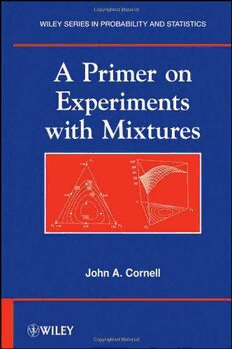Table Of ContentP1:OTA
fm JWBS058-Cornell June28,2011 10:58 PrinterName:YettoCome
A Primer on Experiments with Mixtures
i
P1:OTA
fm JWBS058-Cornell June28,2011 10:58 PrinterName:YettoCome
WILEYSERIESINPROBABILITYANDSTATISTICS
EstablishedbyWALTERA.SHEWHARTandSAMUELS.WILKS
Editors:DavidJ.Balding,NoelA.C.Cressie,GarrettM.Fitzmaurice,
HarveyGoldstein,IainM.Johnstone,GeertMolenberghs,DavidW.Scott,
AdrianF.M.Smith,RueyS.Tsay,SanfordWeisberg
EditorsEmeriti:VicBarnett,J.StuartHunter,JosephB.Kadane,JozefL.Teugels
Acompletelistofthetitlesinthisseriesappearsattheendofthisvolume.
ii
P1:OTA
fm JWBS058-Cornell June28,2011 10:58 PrinterName:YettoCome
A Primer on Experiments
with Mixtures
JOHNA.CORNELL
UniversityofFlorida
DepartmentofStatistics
Gainesville,FL
AJOHNWILEY&SONS,INC.,PUBLICATION
iii
P1:OTA
fm JWBS058-Cornell June28,2011 10:58 PrinterName:YettoCome
Copyright(cid:1)C 2011byJohnWiley&Sons,Inc.Allrightsreserved
PublishedbyJohnWiley&Sons,Inc.,Hoboken,NewJersey
PublishedsimultaneouslyinCanada
Nopartofthispublicationmaybereproduced,storedinaretrievalsystem,ortransmittedinanyformor
byanymeans,electronic,mechanical,photocopying,recording,scanning,orotherwise,exceptas
permittedunderSection107or108ofthe1976UnitedStatesCopyrightAct,withouteithertheprior
writtenpermissionofthePublisher,orauthorizationthroughpaymentoftheappropriateper-copyfeeto
theCopyrightClearanceCenter,Inc.,222RosewoodDrive,Danvers,MA01923,(978)750-8400,
fax(978)750-4470,oronthewebatwww.copyright.com.RequeststothePublisherforpermission
shouldbeaddressedtothePermissionsDepartment,JohnWiley&Sons,Inc.,111RiverStreet,Hoboken,
NJ07030,(201)748-6011,fax(201)748-6008,oronlineathttp://www.wiley.com/go/permission.
LimitofLiability/DisclaimerofWarranty:Whilethepublisherandauthorhaveusedtheirbesteffortsin
preparingthisbook,theymakenorepresentationsorwarrantieswithrespecttotheaccuracyor
completenessofthecontentsofthisbookandspecificallydisclaimanyimpliedwarrantiesof
merchantabilityorfitnessforaparticularpurpose.Nowarrantymaybecreatedorextendedbysales
representativesorwrittensalesmaterials.Theadviceandstrategiescontainedhereinmaynotbesuitable
foryoursituation.Youshouldconsultwithaprofessionalwhereappropriate.Neitherthepublishernor
authorshallbeliableforanylossofprofitoranyothercommercialdamages,includingbutnotlimitedto
special,incidental,consequential,orotherdamages.
Forgeneralinformationonourotherproductsandservicesorfortechnicalsupport,pleasecontactour
CustomerCareDepartmentwithintheUnitedStatesat(800)762-2974,outsidetheUnitedStatesat
(317)572-3993orfax(317)572-4002.
Wileyalsopublishesitsbooksinavarietyofelectronicformats.Somecontentthatappearsinprintmay
notbeavailableinelectronicformats.FormoreinformationaboutWileyproducts,visitourwebsiteat
www.wiley.com.
LibraryofCongressCataloging-in-PublicationData
Cornell,JohnA.,1941-
Aprimeronexperimentswithmixtures/JohnA.Cornell.
p.cm.
Includesbibliographicalreferencesandindex.
ISBN978-0-470-64338-9(cloth)
1.Mixtures—Experiments. 2.Solution(Chemistry)—Experiments. 3.Powders—
Mixing—Experiments. 4.Mixtures—Mathematicalmodels. 5.Solution(Chemistry)—Mathematical
models. 6.Powders—Mixing—Mathematicalmodels. I.Title.
TP156.M5C67 2011
660(cid:2).294—dc22
2010030990
PrintedintheUnitedStatesofAmerica
10 9 8 7 6 5 4 3 2 1
i
P1:OTA
fm JWBS058-Cornell June28,2011 10:58 PrinterName:YettoCome
Contents
Preface ix
1. Introduction 1
1.1 TheOriginalMixtureProblem, 2
1.2 APesticideExampleInvolvingTwoChemicals, 2
1.3 GeneralRemarksAboutResponseSurfaceMethods, 9
1.4 AnHistoricalPerspective, 13
ReferencesandRecommendedReading, 17
Questions, 17
Appendix1A:TestingforNonlinearBlendingoftheTwoChemicals
VendexandKelthaneWhileMeasuringtheAveragePercentMortality
(APM)ofMites, 20
2. TheOriginalMixtureProblem:DesignsandModelsforExploring
theEntireSimplexFactorSpace 23
2.1 TheSimplex-LatticeDesigns, 23
2.2 TheCanonicalPolynomials, 26
2.3 ThePolynomialCoefficientsAsFunctionsoftheResponsesat
thePointsoftheLattices, 31
2.4 EstimatingTheParametersinthe{q,m}Polynomials, 34
2.5 PropertiesoftheEstimateoftheResponse, yˆ(x), 37
2.6 AThree-ComponentYarnExampleUsingA{3,2}
Simplex-LatticeDesign, 38
2.7 TheAnalysisofVarianceTable, 42
2.8 AnalysisofVarianceCalculationsoftheYarnElongationData, 45
2.9 ThePlottingofIndividualResiduals, 48
2.10 TestingtheDegreeoftheFittedModel:AQuadraticModelor
PlanarModel?, 49
v
P1:OTA
fm JWBS058-Cornell June28,2011 10:58 PrinterName:YettoCome
vi CONTENTS
2.11 TestingModelLackofFitUsingExtraPointsandReplicated
Observations, 55
2.12 TheSimplex-CentroidDesignandAssociatedPolynomial
Model, 58
2.13 AnApplicationofaFour-ComponentSimplex-CentroidDesign:
BlendingChemicalPesticidesforControlofMites, 60
2.14 AxialDesigns, 62
2.15 CommentsonaComparisonMadeBetweenAnAugmented
Simplex-CentroidDesignandaFullCubicLatticeforThree
ComponentsWhereEachDesignContainsTenPoints, 66
2.16 ReparameterizingScheffe´’sMixtureModelstoContainA
Constant(β )Term:ANumericalExample, 69
0
2.17 QuestionstoConsideratthePlanningStagesofaMixture
Experiment, 77
2.18 Summary, 78
ReferencesandRecommendedReading, 78
Questions, 80
Appendix2A:Least-SquaresEstimationFormulaforthePolynomial
CoefficientsandTheirVariances:MatrixNotation, 85
Appendix2B:CubicandQuarticPolynomialsandFormulasforthe
EstimatesoftheCoefficients, 90
Appendix2C:ThePartitioningoftheSourcesintheAnalysisof
VarianceTableWhenFittingtheScheffe´ MixtureModels, 91
3. MultipleConstraintsontheComponentProportions 95
3.1 Lower-BoundRestrictionsonSomeorAlloftheComponent
Proportions, 95
3.2 IntroducingL-Pseudocomponents, 97
3.3 ANumericalExampleofFittingAnL-PseudocomponentModel, 99
3.4 Upper-BoundRestrictionsonSomeorAll
ComponentProportions, 101
3.5 AnExampleofthePlacingofanUpperBoundonaSingle
Component:TheFormulationofaTropicalBeverage, 103
3.6 IntroducingU-Pseudocomponents, 107
3.7 ThePlacingofBothUpperandLowerBoundsonthe
ComponentProportions, 112
3.8 FormulasForEnumeratingtheNumberofExtremeVertices,
Edges,andTwo-DimensionalFacesoftheConstrainedRegion, 119
3.9 McLeanandAnderson’sAlgorithmForCalculatingthe
CoordinatesoftheExtremeVerticesofaConstrainedRegion, 123
3.10 MulticomponentConstraints, 128
P1:OTA
fm JWBS058-Cornell June28,2011 10:58 PrinterName:YettoCome
CONTENTS vii
3.11 SomeExamplesofDesignsforConstrainedMixtureRegions:
CONVRTandCONAEVPrograms, 131
3.12 MultipleLatticesforMajorandMinorComponent
Classifications, 138
Summary, 154
ReferencesandRecommendedReading, 155
Questions, 157
4. TheAnalysisofMixtureData 159
4.1 TechniquesUsedintheAnalysisofMixtureData, 160
4.2 TestStatisticsforTestingtheUsefulnessoftheTermsinthe
Scheffe´ Polynomials, 163
4.3 ModelReduction, 170
4.4 AnExampleofReducingtheSystemfromThreetoTwo
Components, 173
4.5 ScreeningComponents, 175
4.6 OtherTechniquesUsedtoMeasureComponentEffects, 179
4.7 LeverageandtheHatMatrix, 190
4.8 AThree-ComponentPropellantExample, 192
4.9 Summary, 195
ReferencesandRecommendedReading, 196
Questions, 197
5. OtherMixtureModelForms 201
5.1 TheInclusionofInverseTermsintheScheffe´ Polynomials, 201
5.2 FittingGasolineOctaneNumbersUsingInverseTermsin
theModel, 204
5.3 AnAlternativeModelFormforModelingtheAdditiveBlending
EffectofOneComponentInaMulticomponentSystem, 205
5.4 ABiologicalExampleontheLinearEffectofaPowder
PesticideInCombinationWithTwoLiquidPesticides
UsedforSuppressingMitePopulationNumbers, 212
5.5 TheUseofRatiosofComponents, 215
5.6 Cox’sMixturePolynomials:MeasuringComponentEffects, 219
5.7 AnExampleIllustratingtheFitsofCox’sModeland
Scheffe´’sPolynomial, 224
5.8 FittingASlack-VariableModel, 229
5.9 ANumericalExampleIllustratingTheFitsofDifferentReduced
Slack-VariableModels:TintStrengthofaHousePaint, 233
5.10 Summary, 239
P1:OTA
fm JWBS058-Cornell June28,2011 10:58 PrinterName:YettoCome
viii CONTENTS
ReferencesandRecommendedReading, 240
Questions, 242
6. TheInclusionofProcessVariablesinMixtureExperiments 247
6.1 DesignsConsistingofSimplex-LatticesandFactorial
Arrangements, 249
6.2 MeasuringtheEffectsofCookingTemperatureandCooking
TimeontheTextureofPattiesMadefromTwoTypesofFish, 251
6.3 Mixture-AmountExperiments, 256
6.4 DeterminingtheOptimalFertilizerBlendandRateforYoung
CitrusTrees, 262
6.5 ANumericalExampleoftheFitofaCombinedModeltoData
CollectedonFractionsoftheFishPattyExperimentalDesign, 269
6.6 QuestionsRaisedandRecommendationsMadeWhenFittinga
CombinedModelContainingMixtureComponentsandOther
Variables, 272
6.7 Summary, 277
ReferencesandRecommendedReading, 278
Questions, 280
Appendix6A:CalculatingtheEstimatedCombinedMixture
Component–ProcessVariableModelofEq.(6.10)Withoutthe
Computer, 282
7. AReviewofLeastSquaresandtheAnalysisofVariance 285
7.1 AReviewofLeastSquares, 285
7.2 TheAnalysisofVariance, 288
7.3 ANumericalExample:ModelingtheTextureofFishPatties, 289
7.4 TheAdjustedMultipleCorrelationCoefficient, 293
7.5 ThePressStatisticandStudentizedResiduals, 293
7.6 TestingHypothesesAbouttheFormoftheModel:Testsof
Significance, 295
ReferencesandRecommendedReading, 298
Bibliography 299
AnswerstoSelectedQuestions 317
Appendix 337
Index 347
P1:OTA
fm JWBS058-Cornell June28,2011 10:58 PrinterName:YettoCome
Preface
In1981,thefirsteditionofExperimentswithMixtureswaspublishedandconsisted
ofonlysevenchaptersand305pages.In1990and2002,thisoriginalfirsteditionwas
greatlyexpandedassecondandthirdeditions.Threechapterswereaddedbringing
thepagecountsto632and649pages,respectively.
The Prefaces to the second and third editions identified the editions as being
suitable for classroom use in a one-semester advanced undergraduate or graduate-
level course. Chapters 1–7 constituted the core material, and Chapters 8–10 could
be selected according to need. Yet, if used as a reference for self-study, Chapters
1–2and4–7providethenecessarytoolsfordealingwithalmostanytypeofmixture
problem.Havingretiredfromacademein2003butoccasionallywasaskedtopresent
talksandshortcoursesonDesignsandModelsforMixtureExperiments,Ibeganto
questionwhetherornotallthethirdeditionmaterialisreallynecessary,particularly
asaninitialoffering.Inmyopinion,thethirdeditioncontainsmuchmorematerial
thancanbecoveredinashortcourseofferedfor1,2,or3daysorevenaone-semester
graduate-levelcourse.Evenifstudentsenrolledinagraduate-levelmixturescourse
werepreviouslytrainedinthedesignofexperiments,orattendeesatashortcourse
onmixtureswerepreviouslyeducatedaschemistsorengineersoreveninstatistics,
itisquitelikelymostofthemareseeingthebasicmixturesmaterialfortheveryfirst
time.
While thinking about the future of training scientists in statistics and other dis-
ciplinesaboutmixturedesignsandmodels,IbelieveDr.WendellSmith’sexcellent
book on Experimental Design for Formulation and my 3rd edition of Experiments
withMixtures:Designs,Models,andtheAnalysisofMixtureData,shouldstillserve
mixture-knowledgeableresearchersinacademe,industry,andgovernmentalpositions
quitenicelyoverthenextdecade.Shortcoursesthatfocusonsoftwareandprovide
mixturedesignsandcombinedmixturecomponents–processvariablesdesignsought
tobenefitfromDr.Smith’sbookandmy3rdedition.WhatIfeelisdesperatelyneeded
andhastakentoolongatimecomingisamuchstrongeremphasisonteaching,that
is,teachingscientistsandplant-levelpersonnelhowtorecognizewhentheyhaveen-
counteredamixtureenvironment.Andthentheword“primer”cametomind.Taken
fromtheFrenchwordprimaire,mycopyofWebster’sdictionarydefined“primer,n”
ix

